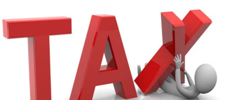It is tax time again. If you are preparing to lodge your 2020 tax return, you must read this article. In the article, I discuss the following:
- The most common myth about tax return
- Substantiation requirements
- The list of common tax deductions
We are Chartered Tax Advisers™ and Certified Financial Planners™. These are the highest professional recognition accorded to specialist tax advisers who are members of the Tax Institute of Australia and Financial Planners who are members of the Financial Planning Association of Australia (FPA), respectively. If you need assistance with your income tax, click here to download our income tax lodgement questionnaire.
The myth
If I claim an expenditure in my tax return, I get a refund equivalent to the whole amount I have claimed. This is a myth.
Whether or not you get a refund when you claim an expense in your tax return and the extent of the refund depends on ALL the followings:
- your employer withholds and emits to the tax office the correct amount of tax on your income;
- Your marginal tax rate;
- The amount of tax credits you have with the ATO, representing tax paid by your employer on your wages.
You will only be entitled to a refund if your employer has withheld the correct of amount of tax and paid it to the ATO. In that case, your refund equals to the expense claimed multiplied by your marginal tax rate, adjusted for Medicare Levy. However, the total amount of refund you can get cannot exceed tax paid by your employer to the ATO.
Where an employer has not withheld the correct amount of tax on your wages, any tax shields associated with your deductions will first be applied against your tax debt with the ATO and only when that debt is fully distinguished, do you get a refund.
Take Peter Lovesmoney for example. He earned total wages of $90,000 for the 2020 financial year. His employer withheld a total of $21,517 from his income and paid it to the ATO, which equates to the legal amount of tax payable on his income.
Peter is in an Australian residence for tax purposes. His marginal tax rate is 32.5% plus 2% Medicare Levy. Peter claims total work-related expenses of $2,000. The refund he will get is $2,000 x 34.5% = $690.
If his employer $690 less than, then his refund would have been applied against his liability. On the other hand, assume the employer only withheld $20,000. In this case, without claiming an expense, Peter would have a liability of $1,517. By claiming $2,000, the liability is reduced by $690 to $827.
Substantiation requirements
Under the laws, you are required to maintain written evidence of all expenses you claim in tax return if the total amount of deductions you are claiming is greater than $300. The records you keep must prove the total amount, not just the amount over $300. The $300 does not include car and meal allowance, award transport payments allowance and travel allowance expenses.
If the total amount you are claiming is $300 or less, you need to be able to show how you worked out your claims, but you do not need written evidence.
You must keep these records for five years from when you lodged your tax return. The ATO can impose financial and other penalties for claiming expenses that cannot be substantiated including penalties, shortfall, and general interest charge and in some in severe cases, prosecution leading to imprisonment.
Common deductions
- Work-related car expenses
You can claim a deduction for the cost of car used for work purposes. This includes amounts incurred to drive between multiple work locations, visit clients and/or transport good. However, the cost of driving from home to work is not deductible. The ATO provides the following two methods for you to select from:
- Cents per kilometre method
- Logbook method.
The method you select affects how much you can claim and therefore your refund. For example, where you qualify to use the logoobk method, you can claim a deduction for the business use of all the running cost of the car including petrol, insurance, registration, repairs as well as the decline in value of the car.
If you are unsure what method to select or need more information, please call 0432 674 668 or email: sekou@epicpm.com.au
- Work-related travel expenses
This refers to other travel expenses for which you did not use your car and includes:
- Overnight hotel stays while on a work trip
- Car hire charges
- Tax fares
- Flights
- Train and bus fares
- Food when staying away from home overnight
- Work-related uniform, occupation specific or protective clothing
This includes:
- a uniform (with a logo)
- protective clothing
- protective shoes
- glasses, goggles, gloves etc.
- high-vis clothing or
- safety equipment
- fire-resistant and sun-protection clothing
- safety-coloured vests
- non-slip nurse’s shoes
- rubber boots for concreters
- steel-capped boots, gloves, and heavy-duty shirts and trousers
- overalls, smocks or aprons you wear to avoid damage or soiling your ordinary clothes during your income-earning activities.
- Self-education
Self-education expenses are deductible when the course you undertake leads to a formal qualification and meets the following conditions.
The course must have a sufficient connection to your current work activities as an employee and:
- maintain or improve the specific skills or knowledge you require in your current work activities
- result in, or is likely to result in, an increase in your income from your current work activities.
You cannot claim a deduction for self-education expenses for a course that does not have a sufficient connection to your current work activities even though it:
- might be generally related to it – such as undertaking a full-time fashion photography course and working as a casual sales assistant on the weekends
- enables you to get new employment – such as moving employment as a nurse to employment as a doctor.
- Donations
To claim a deduction for a donation, it must be made to a deductible gift recipient. You can check whether or not a charity is a deductible gift recipient by going www.abr.gov.au and doing an ABN search. The ABN detail lists the entity’s deductible gift status.
- Income protection premiums
If you pay amount for income protection or salary continuance insurance that is not in your super, you can claim a deduction for it.
- Interest deductions
You can claim a deduction for interest expense incurred in generating investment income. This includes interest paid on borrowing to invest into shares, managed investment schemes, residential and commercial property.
- Personal super contributions
You can claim a tax deduction for contributions you make into super if it meets all of the following conditions:
It is made to a complying super fund that is not a defined benefit interest in a Commonwealth public sector super scheme, an untaxed super fund or a fund prescribed by regulations that prevents members from claiming tax deductions. As at the time of writing this article, there were no such funds.
- You deduct the contribution for the income year in which the contribution is made.
- You submit a valid notice of deductions to your super fund trustee
- The fund trustee gives you an acknowledgement of receipt of your valid
- General deductions
- bank charges
- ongoing financial adviser fees for managing income producing investments like shares and managed funds
- electoral expenses
- foreign exchange losses
- cost of tax advice
- cost of lodging previous year tax return
- rental property expenses
- cost of purchasing equipment and tools use for work like phones, laptops, and tablets.
- Home office expense where work is performed at home
Click here now to download our tax preparation questionnaire and send it to us to prepare your tax return.





